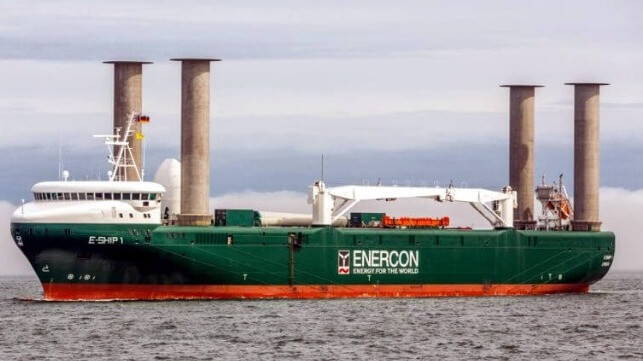Research Shows Adding Flap Improves Rotor Performance

Wind-assisted propulsion, including the century-old Flettner rotor, is increasingly drawing interest as the shipping industry looks for solutions to enhance its efficiency and reduce emissions. A group of researchers from The Netherlands is reporting that they have developed a simple modification for the Flettner rotor that would significantly improve its performance and address some of the issues including a relatively large drag which reduces the aerodynamic efficiency of the original design.
The modern concept of the rotor was developed about 100 years ago based on the Magnus effect. The spinning rotor, when positioned in the wind, creates a forward thrust on the vessel providing wind-assisted propulsion. Several companies over the past decade had developed forms of the technology and it has begun to be used on a range of vessels while designs have looked at it for everything from ultra-large tankers to bulkers and other ocean-going vessels.
The Technical University Delft and the Sea Axe Fund have been researching concepts to make the rotor technology more efficient and address issues such as the relatively large drag. In certain wind conditions, the rotor also creates lift and drag in a reduced downwash resulting in less accelerated flow in the rotor wake. Vessels are required to compensate with rudder angles to reach a sailing equilibrium and reduce the heeling effect.
TU Delft hit upon the idea of incorporating a flap to the rotor to fix the flow separation point which alters the lift and drag forces created. They approached Blue Wasp Marine, a Dutch company dedicated to wind propulsion to test the design concepts.
Blue Wasp is reporting that its test shows the inclusion of the flap lower fuel consumption by a significant 35 percent. By comparison, Norsepower Rotor Sails, one of the commercial providers of the technology says in its market that it can typically produce 5 to 20 percent fuel savings while another company Anemoi Rotor Sails says it can reduce emissions by up to 30 percent.
“Our results demonstrate how a small adjustment to a Flettner rotor can have a big impact, making shipping operations considerably cleaner and more cost-effective,” said Giovanni Bordogna, founding partner and aerodynamics specialist at Blue Wasp Marine.

Nearshore cargo vessel incorporating the flap into the rotor wind sail (Blue Wasp)
Blue Wasp conducted tests at the wind tunnel at the Politecnico de Milano in Italy. This information was then combined with the in-built force models of Blue Wasp’s Pelican software. They established a series of controls to ensure the accuracy of the experiment, looking at one vessel with a Flettner rotor and one with rotor and flap, sailing at the same speed, in the same conditions, and on the same route.
The study was performed with the Damen Combi Freighter 5000, which Blue Wasp says at 282 feet in length serves as a good representative of its type and indicates the effects of the Flettner rotor and flap on a nearshore cargo vessel. Factors included in the tests were the thrust of the Flettner rotor, wind, resistance in both waves and calm water, and resistance resulting from leeway, heeling and rudder operation. The performance of the two vessels was considered over the same North Sea route, between Rotterdam, the Netherlands, and Trondheim, Norway.
The tests demonstrated that the addition of the flap delivered a significant increase in aerodynamic thrust. According to Blue Wasp, the vessel equipped with the Flettner rotor and flap has a tacking angle in the region of 15 degrees smaller than the one with only the rotor. This allows the vessel to sail significantly closer to the wind, vastly improving the efficiency of performance upwind.
Though not a part of the study, the results also established that, in most positions, the flap’s decreases of lift and drag resulted in reduced downwash and less accelerated flow in the rotor wake. This results in a relatively smaller aerodynamic sideforce, requiring smaller heeling, leeway, and rudder angles to reach sailing equilibrium. This means that the vessel with the rotor and flap can operate at higher wind speeds.
“This research demonstrates how small modifications to well-known rotor systems can already make a big difference in the propulsion efficiency of wind-assisted ships,” said Albert Rijkens of TU Delft. “Wind-assisted ship prolusion has found renewed interest from the shipping industry to meet the global climate goals and it will play a vital role to lower emissions, especially for large ocean-going vessels.”
The Delft University of Technology reports will continue to intensify its research in this area by making wind-assisted ship propulsion one of its spearheads of maritime research for the coming years.
